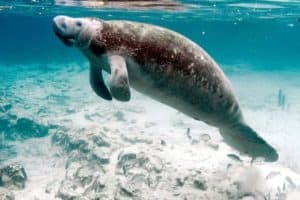How old is the oldest manatee ever recorded? And how does this easygoing animal affectionately dubbed the “sea cow” contribute to conservation efforts for animals worldwide?
To answer these questions, we need to learn a bit more about this very unique mammal!
Manatees are one of the most loved animals in the world and with good reason! These gentle sea mammals are friendly, fun-loving and live their lives at an easy pace. Perhaps this easygoing approach is the secret to the manatee’s long lifespan!
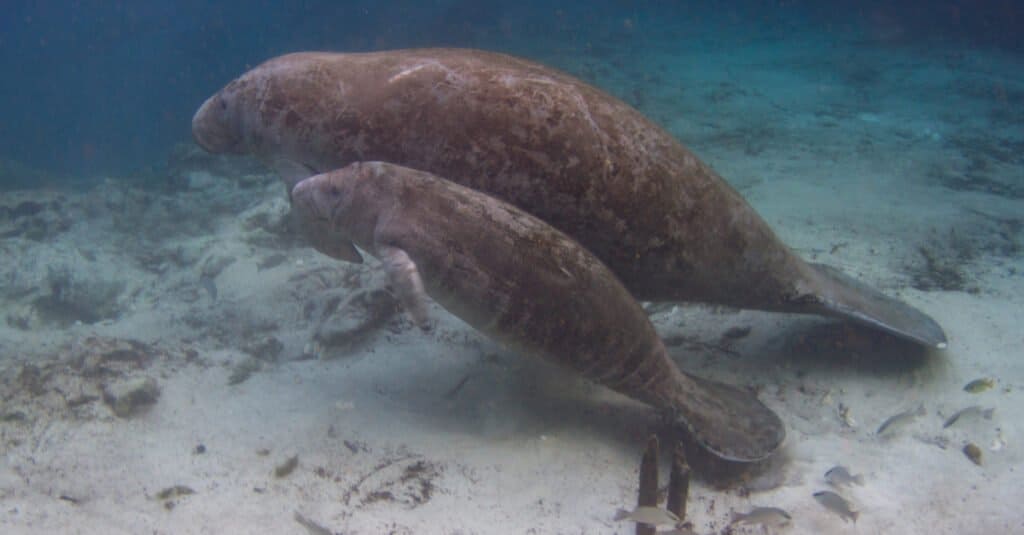
Manatees are one of the most beloved sea mammals!
©Peter Douglas Clark/Shutterstock.com
The Gentle Giant of The Aquatic Ecosystem
Manatees are the only living member of the Family Trichechidae. They are grouped with the Dugongidae Family under the Order Sirenia. Mammals grouped under the Proboscidea Order are their closest living relatives. This makes the elephant the manatee’s distant cousin!
Manatees are aquatic mammals that feed exclusively on plant life. They must consume large quantities to sustain themselves, as this vegetation is low on protein and nutrients. Their unique physical adaptations and hindgut digestive system are designed for a vegetarian lifestyle. They have large prehensile lips studded with sensory bristles to find and select edible plants Their molars are lost and regrown regularly due to abrasive sand and sediment. This causes wear so teeth are replaced to cope with their dietary needs. Worn teeth move to the front of the mouth when new molars come in. Then they are eventually lost and replaced throughout the entire lifespan of the manatee.
Manatee Physical Characteristics
Manatees differ in size depending on the species, and some physical characteristics differ slightly as well. In general, manatees are between 8-13 feet long and weigh between 1,056 and 3,650 pounds. This largely depends on the species. They are varying shades of grey, black or brown. Manatees have stout and tapered bodies and flat rounded tails used for propulsion. They have two front flippers but lack hind flippers or legs. They use their flippers for turning, swimming, handling food, and bottom walking.
Manatees are dense and heavy animals because their ribs do not have marrow. They can control the volume of air spaces in their lungs. The lungs are also oriented to be parallel to the water’s surface. This allows them to keep a horizontal position in water from the bottom to the surface. Manatees can replenish 90 percent of the air in their lungs and stay underwater for over 20 minutes!
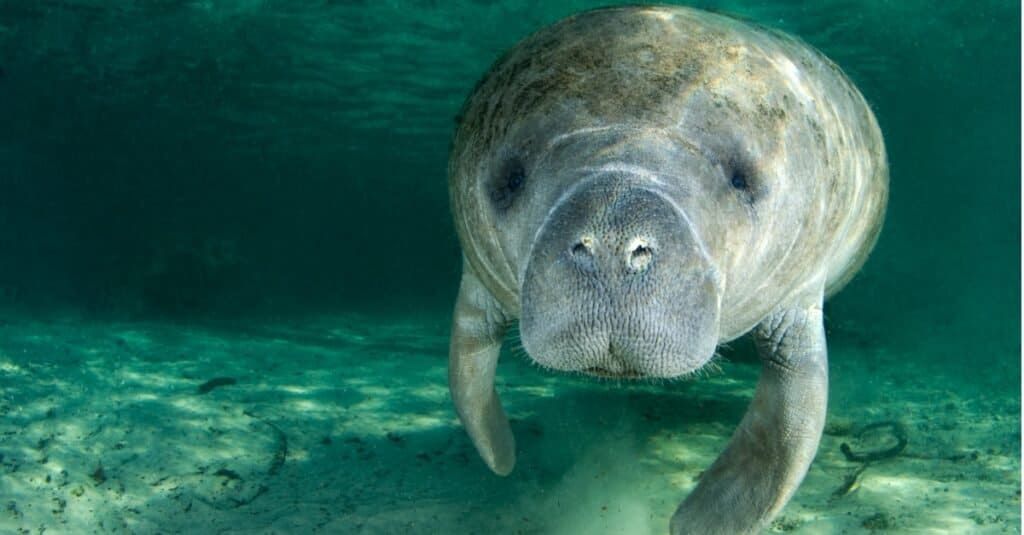
Manatees are friendly but solitary.
©A Cotton Photo/Shutterstock.com
The Long Lifetime of a Manatee
The life of a manatee is largely solitary for such a friendly creature. But solitary groups referred to as aggregations are formed for short periods. These periods can be for hours or for several days. Aggregations of males are formed for mating purposes often involve up to 20 males centered around one receptive female. Aggregations may also form in areas with plentiful food sources or warm water. Manatees are highly sensitive to cold. At times over 300 manatees are known to gather near warm-water outflows near Florida power plants. West Indian manatees (the species found in Florida) migrate South during cold weather seasons. Manatees also migrate in response to fluctuating water conditions.
Manatees can survive for seven months or more without food. This is due to their ability to build up stores of fat and slow metabolic rate. They are active both day and night and can sleep submerged. They also sleep while breathing at the water surface. Manatees move an average of 5 miles an hour. However, they can reach up to 15 miles per hour if needed.
How Do Manatees Communicate?
Manatees communicate using unique underwater sounds. These sounds are generally chirps, squeaks, and grunts. They are also very tactile, with sensory hairs over their bodies. These hairs help the manatee to communicate with touch. They have many hairs are concentrated on the muzzle and face. These types of communication are especially important for communicating with their young.
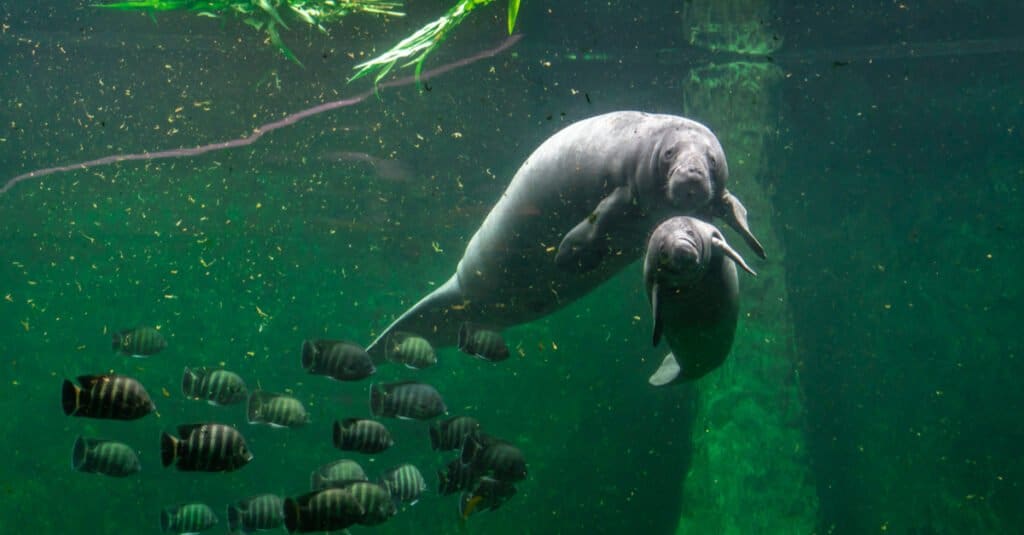
Manatee mother and calf.
©Lukasz Machowczyk/Shutterstock.com
How Does A Manatees Life Start?
All three species mate year-round. They have seasonal mating periods that are high in the spring and lower in the winter months. However, they reproduce slowly. Sexual maturity occurs around 3 years of age. A female manatee will produce a calf every 2-3 years on average. Twin births occur but are very rare. The gestation period for a manatee calf is nearly one year. Calves stay with their mothers for up to two years before reaching adulthood. During this time, they continue to nurse but start consuming plants fairly young.
Manatees have a very long lifespan. Age estimates based on growth rings within the ear bones indicate they can live for over 50 years!
Snooty: The World’s Oldest Recorded Manatee
Snooty was he world’s oldest recorded manatee. He was also the first manatee born in captivity. And the Guinness World Record holder for oldest in captivity, dying just a day before his 69th birthday.
Yes, it was all Snooty, a West Indian manatee born on July 21st, 1948! At the age of two, Snooty was moved to his forever home at the South Florida Museum of Manatee County. He lived in a controlled environment within a 60,000-gallon pool. He shared his home with his fellow manatees Randall, Baca, and Gale.
Snooty Really Liked Visitors!
While Snooty got along well with his aquatic roommates, he displayed a marked preference for people. He enjoyed the company of his caretakers. Snooty was also known to be highly affectionate and playful as well. He welcomed new guests and enjoyed a good belly rub. All in all, he was well-loved by countless fans and adored by the entire state of Florida.
Snooty Was A Conservationist!
Snooty’s fame and notoriety were a driving force in the conservation and preservation of his species worldwide, and his gentle and sweet personality warmed the hearts of millions for almost seven decades.
“He’s just entertaining and calming at the same time,” Marilyn Margold, director of living collections at South Florida Museum, told Guinness World Records in 2016.
Rest In Peace, Dear Snooty
Sadly, Snooty passed away just a day after celebrating his 69th birthday. Due to a tragic accident, Snooty became trapped in the underwater plumbing for the exhibit life support system. This accident was caused by a damaged access panel that allowed him to enter.
Unfortunately, Snooty did enter but was unable to find a way out. While museum workers scrambled to find a way to rescue him, they, unfortunately, did not get to Snooty in time to save his life.
A Touching Tribute To Snooty
The Chief Operating Officer of the South Florida Museum, Jeff Rogers, released the following statement about the loss of Snooty:
“We’re all devastated about his passing. Snooty was such a unique animal and he had so much personality that people couldn’t help but be drawn to him. As you can imagine, I – and our staff, volunteers, and board members – considered him a star. We all deeply mourn his passing.”
Snooty will be forever remembered as the oldest and most well-loved manatee.
In addition to Snooty, the second oldest living manatee recorded in the wild was estimated to be 59 years old.
Conservation: Manatees Are Endangered
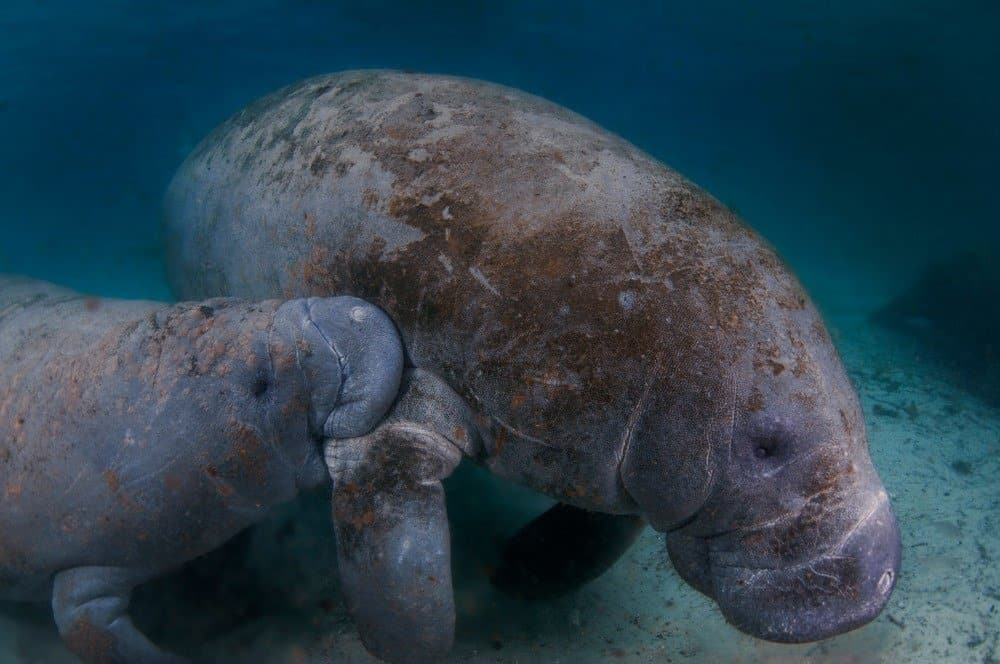
Manatees have the ability to live for a long time, but many only survive for 10 years in the wild
©Greg Amptman/Shutterstock.com
The manatee has the natural ability to live for over 50 years. However, many do not make it past the age of ten. Manatees have no natural predators. In fact, even the largest of Florida’s alligators will allow a manatee to pass them in peace.
The biggest and only real threat to this majestic animal is humanity. This is largely due to pollution of their food sources caused by fertilizer runoff and septic and sewage leaks. These conditions often result in algae bloom in their habitat. Algae bloom causes destruction to vast acres of seagrass the manatee depends on.
Additionally, collisions with watercraft and alarming temperature changes threaten manatees. All of these factors contribute to the dangers human beings cause to all three species. Due to these man-made threats to the manatee, they are protected under the Endangered Species Act. Additionally, they also fall under the Marine Mammal Protection Act.
The Florida manatee is protected by the Florida Sanctuary Act of 1978 as well. This explicitly states that “it is unlawful for any person, at any time, intentionally or negligently, to annoy, molest, harass or disturb any manatee.”
The photo featured at the top of this post is © 272007413/Shutterstock.com
Thank you for reading! Have some feedback for us? Contact the AZ Animals editorial team.




